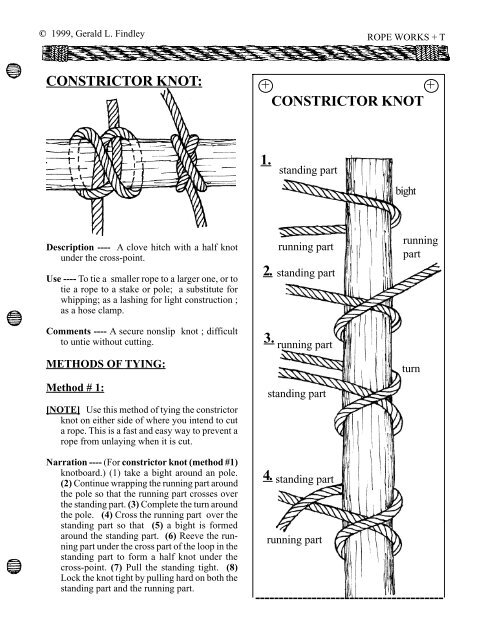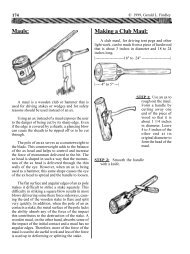CONSTRICTOR KNOT: + + CONSTRICTOR KNOT 3 ... - Rope Works
CONSTRICTOR KNOT: + + CONSTRICTOR KNOT 3 ... - Rope Works
CONSTRICTOR KNOT: + + CONSTRICTOR KNOT 3 ... - Rope Works
Create successful ePaper yourself
Turn your PDF publications into a flip-book with our unique Google optimized e-Paper software.
© 1999, Gerald L. Findley ROPE WORKS + T<br />
<strong>CONSTRICTOR</strong> <strong>KNOT</strong>: + +<br />
<strong>CONSTRICTOR</strong> <strong>KNOT</strong><br />
Description ---- A clove hitch with a half knot<br />
under the cross-point.<br />
Use ---- To tie a smaller rope to a larger one, or to<br />
tie a rope to a stake or pole; a substitute for<br />
whipping; as a lashing for light construction ;<br />
as a hose clamp.<br />
Comments ---- A secure nonslip knot ; difficult<br />
to untie without cutting.<br />
METHODS OF TYING:<br />
Method # 1:<br />
[NOTE] Use this method of tying the constrictor<br />
knot on either side of where you intend to cut<br />
a rope. This is a fast and easy way to prevent a<br />
rope from unlaying when it is cut.<br />
Narration ---- (For constrictor knot (method #1)<br />
knotboard.) (1) take a bight around an pole.<br />
(2) Continue wrapping the running part around<br />
the pole so that the running part crosses over<br />
the standing part. (3) Complete the turn around<br />
the pole. (4) Cross the running part over the<br />
standing part so that (5) a bight is formed<br />
around the standing part. (6) Reeve the running<br />
part under the cross part of the loop in the<br />
standing part to form a half knot under the<br />
cross-point. (7) Pull the standing tight. (8)<br />
Lock the knot tight by pulling hard on both the<br />
standing part and the running part.<br />
1.<br />
2.<br />
3.<br />
4.<br />
standing part<br />
running part<br />
standing part<br />
running part<br />
standing part<br />
standing part<br />
running part<br />
bight<br />
running<br />
part<br />
turn<br />
---------------------------------------
© 1999, Gerald L. Findley ROPE WORKS + T<br />
-----------------------------------------<br />
5.<br />
6.<br />
7.<br />
8.<br />
standing part<br />
bight<br />
running part<br />
standing part<br />
half knot ----<br />
<br />
pull<br />
hard<br />
-------><br />
pull<br />
hard<br />
+ +<br />
METHODS OF TYING:<br />
Method # 2: Over the end of a pole or rope.<br />
[ 1 ] Start with an underhand loop laid on the pole.<br />
underhand<br />
loop<br />
[ 2 ] Place the loop over the end of the pole.<br />
[ 3 ] Pull the opposite side of the loop down and<br />
under the cross point of the underhand loop<br />
down & under
© 1999, Gerald L. Findley ROPE WORKS + T<br />
[ 4 ] ...... then pull it up and over the end of the<br />
pole ......<br />
[ 5 ] ..... to form a second loop around the pole and<br />
a half knot under the cross point of the knot.<br />
2nd loop ---<br />
half knot<br />
[ 6 ] Pull the two ends tight. The harder you pull<br />
the tighter the knot.<br />
pull<br />
Method # 3: Slippery constrictor knot.<br />
[NOTE] This method of tying the constrictor<br />
knot allows it to be untied quickly and easily.<br />
1.<br />
2.<br />
3.<br />
4.<br />
running part<br />
standing<br />
part<br />
running<br />
part<br />
bight<br />
<br />
pull<br />
bight
© 1999, Gerald L. Findley ROPE WORKS + T<br />
Narration -----(For slippery constrictor knot<br />
knotboard.) (1) Tie the slippery constrictor knot<br />
the same way as a regular constrictor knot but<br />
(2) form a bight in the running end before it is<br />
(3) reeved under the cross part of the loop in<br />
the standing part. Pull the standing tight. (4)<br />
Lock the half knot tight by pulling hard on both<br />
the standing part and the running part.<br />
Method # 4: As a lashing.<br />
SUGGESTED USES: For the constrictor<br />
knot.<br />
whipping<br />
spaced rungs<br />
tying to a stake or pole<br />
round lashing<br />
[NOTES]




